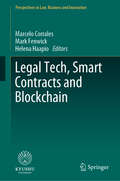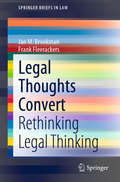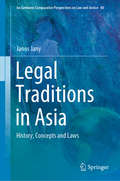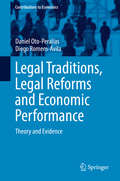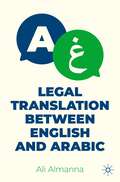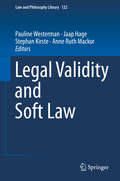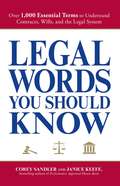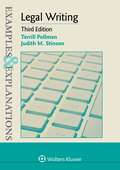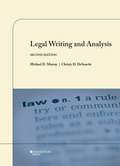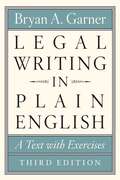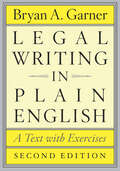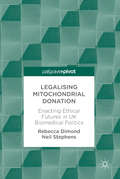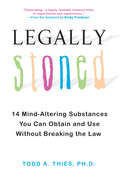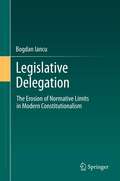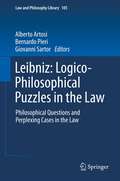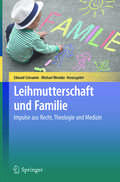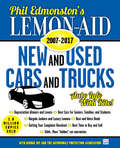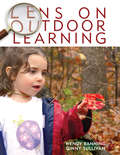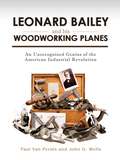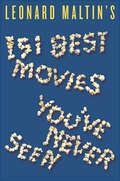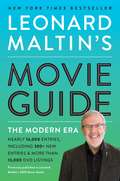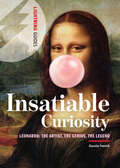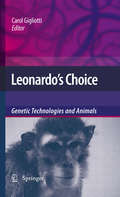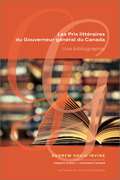- Table View
- List View
Legal Tech, Smart Contracts and Blockchain (Perspectives in Law, Business and Innovation)
by Helena Haapio Mark Fenwick Marcelo CorralesThere is a broad consensus amongst law firms and in-house legal departments that next generation “Legal Tech” – particularly in the form of Blockchain-based technologies and Smart Contracts – will have a profound impact on the future operations of all legal service providers. Legal Tech startups are already revolutionizing the legal industry by increasing the speed and efficiency of traditional legal services or replacing them altogether with new technologies. This on-going process of disruption within the legal profession offers significant opportunities for all business. However, it also poses a number of challenges for practitioners, trade associations, technology vendors, and regulators who often struggle to keep up with the technologies, resulting in a widening regulatory “gap.” Many uncertainties remain regarding the scope, direction, and effects of these new technologies and their integration with existing practices and legacy systems. Adding to the challenges is the growing need for easy-to-use contracting solutions, on the one hand, and for protecting the users of such solutions, on the other. To respond to the challenges and to provide better legal communications, systems, and services Legal Tech scholars and practitioners have found allies in the emerging field of Legal Design. This collection brings together leading scholars and practitioners working on these issues from diverse jurisdictions. The aim is to introduce Blockchain and Smart Contract technologies, and to examine their on-going impact on the legal profession, business and regulators.
Legal Thoughts Convert: Rethinking Legal Thinking (SpringerBriefs in Law)
by Jan M. Broekman Frank FleerackersThis book highlights how conversion via communication is one of the most important issues in legal thinking. A major aspect is its link with language – legal texts, judgments, opinions and legal concepts included. Further, conversion is connected to all social positions in law. But a jurist will not solely master specific social behaviors or become the manager of large-scale political fields of law as a legal scientist. A continuously changing integration opens up to his views on reality as it presents itself incessantly. Law and its functionaries are in a never-ending process of change in all domains of culture, which mark the 21st century. Conversions thus concern the riddle of wisdom and automatism, of individual privacy and social fixations, of philosophical considerations and converting flows.
Legal Traditions in Asia: History, Concepts and Laws (Ius Gentium: Comparative Perspectives on Law and Justice #80)
by Janos JanyThis book offers a comparative analysis of traditional Asian legal systems. It combines methods from legal history, legal anthropology, legal philosophy, and substantive law, pursuing a comprehensive approach that offers readers a broad perspective on the topic. The geographic regions covered include the Near East, Middle East, Central Asia, India, China, Japan, and Southeast Asia. For each region, the book first provides historical and political context. Next, it discusses major milestones in the region’s legal history and political institutions, as well as its forms of government. Readers are then presented with fundamental principles and terms needed to understand the legal arguments discussed. The book begins with the Ancient Near East and important topics such as Jewish law. The next part considers Islamic law, while also exploring modern issues. The third part focuses on Hindu and Buddhist law, while the fourth part covers China and Japan. The book’s closing section examines tribal societies, e.g. Mongols, Pashtuns and Malays. Topics covered include the interaction of legal systems within a legal circle, inter-systemic interactions, reasons for the failure and success of legal modernization, legal pluralism, and its effects on Asian societies. Family law, law of obligation, criminal law, and procedural law are also explored.
Legal Traditions, Legal Reforms and Economic Performance
by Diego Romero-Ávila Daniel Oto-PeralíasThis book investigates whether legal reforms intended to create a market-friendly regulatory business environment have a positive impact on economic and financial outcomes. After conducting a critical review of the legal origins literature, the authors first analyze the evolution of legal rules and regulations during the last decade (2006-2014). For that purpose, the book uses legal/regulatory indicators from the World Bank's Doing Business Project (2015). The findings indicate that countries have actively reformed their legal systems during this period, particularly French civil law countries. A process of convergence in the evolution of legal rules and regulations is observed: countries starting in 2006 in a lower position have improved more than countries with better initial scores. Also, French civil law countries have reformed their legal systems to a larger extent than common law countries and, consequently, have improved more in the majority of the Doing Business indicators used. Second, the authors estimate fixed-effects panel regressions to analyze the relationship between changes in legal rules and regulations and changes in the real economy. The findings point to a lack of systematic effects of legal rules and regulations on economic and financial outcomes. This result stands in contrast to the widespread belief that reforms aiming to strengthen investor and creditor rights (and other market-friendly policies) systematically lead to better economic and financial outcomes.
Legal Translation between English and Arabic
by Ali AlmannaThis is a coursebook designed for students of translation, which will also benefit professional translators as it covers key issues in contemporary legal translation. The book is divided into two main parts. The first, theoretical part, explores issues such as types of legal texts, readership, communicative purpose, global and local strategies, and modality in addition to analysing the common features of legal discourse in both languages, be they lexical, syntactic, or textual. The second, practical part, discusses issues such as legal rights, contractual obligations, torts, crimes, people and law. It focuses on all types of legal texts, regardless of their classification and examines legislative texts, which have acquired a certain degree of notoriety rarely equalled by any other variety of English.
Legal Validity and Soft Law (Law and Philosophy Library #122)
by Jaap Hage Pauline Westerman Stephan Kirste Anne Ruth MackorThis book features essays that investigate the nature of legal validity from the point of view of different traditions and disciplines. Validity is a fascinating and elusive characteristic of law that in itself deserves to be explored, but further investigation is made more acute and necessary by the production, nowadays, of soft law products of regulation, such as declarations, self-regulatory codes, and standardization norms. These types of rules may not exhibit the characteristics of formal law, and may lack full formal validity but yet may have a very real impact on people's lives. The essays focus on the structural properties of hard and soft legal phenomena and the basis of their validity. Some propose to redefine validity: to allow for multiple concepts instead of one and/or to allow for a gradual concept of validity. Others seek to analyze the new situation by linking it to familiar historical debates and well-established theories of law. In addition, coverage looks at the functions of validity itself. The discussion considers both international law as well as domestic law arrangements. What does it mean to say that something is valid? Should we discard validity as the determining aspect of law? If so, what does this mean for our concept of law? Should we differentiate between kinds of validity? Or, can we say that rules can be "more" or "less" valid? After reading this book, practitioners, scholars and students will have a nuanced understanding of these questions and more.Chapter 6 is available open access under a Creative Commons Attribution 4.0 International License via link.springer.com.
Legal Words You Should Know: Over 1,000 Essential Terms to Understand Contracts, Wills, and the Legal System
by Corey Sandler Janice KeefeEvery day, people find themselves in legal situations. Mortgages are put in place, attorneys draw up wills, and credit cards are set up all the time. However, how many people actually understood the legal contracts they were signing? There's no excuse for being ignorant of the law when it comes to a dispute with a bank, a mortgage lender, or a lawyer. This book defines 1,000 essential words from the worlds of civil law, estates, lending, and elder affairs, such as abatement, residuary beneficiary, trust deed, variable rate mortgage, right of rescission, and more. Each word will be clearly defined, and includes a pronunciation key and an example of usage. This guide ensures you will know the law in no time!
Legal Writing (Examples and Explanations)
by Terrill Pollman; Judith M. StinsonA favorite classroom prep tool of successful students that is often recommended by professors, the Examples & Explanations (E&E) series provides an alternative perspective to help you understand your casebook and in-class lectures. Each E&E offers hypothetical questions complemented by detailed explanations that allow you to test your knowledge of the topics in your courses and compare your own analysis.
Legal Writing and Analysis (Coursebook Ser.)
by Michael Murray Christy DeSanctisThis law school text teaches the fundamentals of legal writing, analysis, and the American legal method. It fosters critical lawyering skills, such as how to identify a legal rule from a variety of sources, analyze and explain its components, apply the rule to answer a problem, and communicate the results in an effective manner. In the second edition, coverage of authority and rule formation have been streamlined and tightened. The authors have increased the visual appeal and content of callout boxes, charts, and tables; and they have replaced and shortened the length of examples so as to provide two to three times as many samples of practitioner writing in each chapter. With this new edition, the authors endeavor to train future lawyers to be ethical and professional issue-spotters, analysts, counselors, problem-solvers, and communicators working to advance their clients’ interests.
Legal Writing in Plain English, Third Edition: A Text with Exercises (Chicago Guides to Writing, Editing, and Publishing)
by Bryan A. GarnerThe leading guide to clear writing—and clear thinking—in the legal profession for more than two decades, now newly updated. Admirably clear, concise, down-to-earth, and powerful—all too often, legal writing embodies none of these qualities. Its reputation for obscurity and needless legalese is widespread. Since 2001, Bryan A. Garner’s Legal Writing in Plain English has helped address this problem by providing lawyers, judges, paralegals, law students, and legal scholars with sound advice and practical tools for improving their written work. Now the leading guide to clear writing in the field, this indispensable volume encourages legal writers to challenge conventions and offers valuable insights into the writing process: how to organize ideas, create and refine prose, and improve editing skills. Accessible and witty, Legal Writing in Plain English draws on real-life writing samples that Garner has gathered through decades of teaching experience. Trenchant advice covers all types of legal materials, from analytical and persuasive writing to legal drafting, and the book’s principles are reinforced by sets of basic, intermediate, and advanced exercises in each section. For this third edition, Garner has retained the structure of the previous versions, with updates and new material throughout. There are new sections on making your writing vivid and concrete and on using graphics to enhance your argument. The coverage and examples of key topics such as achieving parallelism, avoiding legalese, writing effective openers and summaries, and weaving quotations into your text have also been expanded. And the sample legal documents and exercises have been updated, while newly added checklists provide quick summaries of each section. Altogether, this new edition will be the most useful yet for legal professionals and students seeking to improve their prose.
Legal Writing in Plain English: A Text with Exercises (Chicago Guides to Writing, Editing, and Publishing)
by Bryan A. Garner“This easy-to-follow guide is useful both as a general course of instruction and as a targeted aid in solving particular legal writing problems.” —Harvard Law ReviewClear, concise, down-to-earth, and powerful—all too often, legal writing embodies none of these qualities. Its reputation for obscurity and needless legalese is widespread. For more than twenty years, Bryan A. Garner’s Legal Writing in Plain English has helped address this problem by providing lawyers, judges, paralegals, law students, and legal scholars with sound advice and practical tools for improving their written work. The leading guide to clear writing in the field, this indispensable volume encourages legal writers to challenge conventions and offers valuable insights into the writing process that will appeal to other professionals: how to organize ideas, create and refine prose, and improve editing skills.Accessible and witty, Legal Writing in Plain English draws on real-life writing samples that Garner has gathered through decades of teaching. Trenchant advice covers all types of legal materials, from analytical and persuasive writing to legal drafting, and the book’s principles are reinforced by sets of basic, intermediate, and advanced exercises in each section.In this new edition, Garner preserves the successful structure of the original while adjusting the content to make it even more classroom-friendly. He includes case examples from the past decade and addresses the widespread use of legal documents in electronic formats. His book remains the standard guide for producing the jargon-free language that clients demand and courts reward.“Those who are willing to approach the book systematically and to complete the exercises will see dramatic improvements in their writing.” —Law Library Journal
Legalising Mitochondrial Donation: Enacting Ethical Futures In Uk Biomedical Politics
by Rebecca Dimond Neil StephensIn 2015 the UK became the first country in the world to legalise mitochondrial donation, a controversial germ line reproductive technology to prevent the transmission of mitochondrial disease. Dimond and Stephens track the intense period of scientific and ethical review, public consultation and parliamentary debates preceeding the decision. They draw on stakeholder accounts and public documents to explore how patients, professionals, institutions and publics mobilised within ‘for’ and ‘against’ clusters, engaging in extensive promissory, emotional, bureaucratic, ethical, embodied and clinical labour to justify competing visions of an ethical future. They describe how this decision is the latest iteration of a UK sociotechnical imaginary in which the further liberalization of human embryo research and use is rendered legitimate and ethical through modes of consultation and permissive but strictly regulated licensing. Overall, this book presents a timely, multi-dimensional, and sociological account of a globally significant landmark in the history of human genetics, and will be relevant to those with an interest in genetics, Science, Technology and Society, the sociology of medicine, reproductive technology, and public policy debate.
Legally Stoned: 14 Mind-Altering Substances You Can Obtain and Use Without Breaking the Law
by Todd A. Thies, Ph.D.This practical guide to psychoactive drugs reveals fourteen legal and accessible paths on your journey to altered consciousness.Getting high in one form or another has been a part of human life for thousands of years. And while the US government stands in the way of this basic right, there are ways around the restrictions. With each of the fourteen psychoactive substances detailed in this book, you can get high, pass a urine drug test, and never once break the law.Legally Stoned is a practical guide to obtaining and using fourteen mind-altering agents that are both legal and easy to acquire. It also includes a description and history of each item, its chemistry and physiological reactions, accounts of its pleasures and perils, and any risks associated with it.Legally Stoned covers substances such as:• Amanita muscaria mushroom, which induces feelings of euphoria and auditory hallucinations• Anadenanthera peregrina/colubrina seeds, which have been known to cause intense visions of psychedelic light and color• Ayahuasca, which originated in South America and often produces visual hallucinations that include the jungle, exotic animals, even ancient native artwork
Legislative Delegation
by Bogdan IancuAn overarching question of contemporary constitutionalism is whether equilibriums devised prior to the emergence of the modern administrative-industrial state can be preserved or recreated by means of fundamental law. The book approaches this problem indirectly, through the conceptual lens offered by constitutional developments relating to the adoption of normative limitations on the delegation of law-making authority. Three analytical strands (constitutional theory, constitutional history, and contemporary constitutional and administrative law) run through the argument. They merge into a broader account of the conceptual ramifications, the phenomenon, and the constitutional treatment of delegation in a number of paradigmatic legal systems. As it is argued, the development and failure of constitutional rules imposing limits on legislative delegation reveal the conditions for the possibility of classical limited government and, conversely, the erosion of normativity in contemporary constitutionalism.
Leibniz: Logico-Philosophical Puzzles in the Law
by Giovanni Sartor Bernardo Pieri Alberto ArtosiThis volume presents two Leibnizian writings, the Specimen of Philosophical Questions Collected from the Law and the Dissertation on Perplexing Cases. These works, originally published in 1664 and 1666, constitute, respectively, Leibniz's thesis for the title of Master of Philosophy and his doctoral dissertation in law. Besides providing evidence of the earliest development of Leibniz's thought and amazing anticipations of his mature views, they present a genuine intellectual interest, for the freshness and originality of Leibniz's reflections on a striking variety of logico-philosophical puzzles drawn from the law. The Specimen addresses puzzling issues resulting from apparent conflicts between law and philosophy (the latter broadly understood as comprising also mathematics, as well as empirical sciences). The Dissertation addresses cases whose solution is puzzling because of the convoluted logical form of legal dispositions and contractual clauses, or because of conflicting priorities between concurring parties. In each case, Leibniz dissects the problems with the greatest ingenuity, disentangling their different aspects, and proposing solutions always reasonable and sometimes surprising. And he does not refrain from peppering his intellectual acrobatics with some humorous comments.
Leihmutterschaft und Familie: Impulse aus Recht, Theologie und Medizin
by Edward Schramm Michael WermkeDas Buch betrachtet das Thema Leihmutterschaft aus einer breit angelegten, interdisziplinären Perspektive. In Deutschland ist die Leihmutterschaft verboten, in vielen anderen Ländern legal. Viele Menschen erfüllen sich den Wunsch nach einem Kind daher im Wege einer Leihmutterschaft im Ausland. Das Buch nimmt dies zum Anlass, aktuelle Erkenntnisse und Impulse aus der Rechtswissenschaft, Theologie, Soziologie, kindlichen Entwicklungspsychologie, Medizin, Genetik und Philosophie zu diesem Phänomen aufzugreifen und zu analysieren. Im Mittelpunkt steht die Frage, inwiefern sich das Wohl des Kindes, die Interessen der Leihmütter sowie die Bedürfnisse der Wunscheltern in der deutschen Rechtsordnung, der sozialen Wirklichkeit und den kirchlichen Institutionen widerspiegeln.
Lemon-Aid New and Used Cars and Trucks 2007–2017
by Phil Edmonston George Iny<p>“Dr. Phil,” Canada’s best-known automotive expert, invites another driver to come aboard. <p>After forty-six years and almost two million copies sold, Phil Edmonston is joined by a co-pilot for the Lemon-Aid Guide — George Iny, along with the editors of the Automobile Protection Association. The 2017 Lemon-Aid has everything: an encyclopedic lineup of the best and worst cars, trucks, and SUVs sold since 2007; secret warranties and tips on the “art of complaining” to help you get your money back; and new-car buying tips that will save you tons of money by revealing the inflated cost of fancy and frivolous add-ons. Lemon-Aid is an essential guide for careful buyers and long-time gear-heads who don't know as much as they think.</p>
Lens on Outdoor Learning
by Wendy Banning Ginny SullivanThe outdoors is full of rich learning experiences for preschool and pre-kindergarten children. Lens on Outdoor Learning is filled with stories and colorful photographs that illustrate how the outdoors supports children's early learning. Each story is connected to an early learning standard such as curiosity and initiative; engagement and persistence; imagination, invention, and creativity; reasoning and problem-solving; risk-taking, responsibility, and confidence; reflection, application, and interpretation; and flexibility and resilience. Much of the teaching in these experiences is indirect and involves provisioning, observing, and conversing with children as they spend quality time in nature. Children's dialogue and actions are included in each story to show just how engaged they became during these experiences. Lens on Outdoor Learning will inspire early childhood professionals to use this outdoor approach in their own setting.Wendy Banning is coordinator of Irvin Learning Farm, an inquiry-based, hands-on outdoor learning space for children and adults in North Carolina. She is also an educational consultant, teacher, trainer, and photographer.Ginny Sullivan is co-principal of Learning by the Yard, a partnership of landscape architects and educators that helps schools develop their grounds as habitat, focusing on native plants. Ginny consults, trains teachers, and involves schools and centers in the design of their outdoor spaces to help children learn about the natural world.
Leonard Bailey and his Woodworking Planes: An Unrecognized Genius of the American Industrial Revolution
by Paul Van Pernis John G. WellsNew Englander Leonard Baileywas one of the inventive geniuses of theAmerican Industrial Revolution. His designs and patented inventions solvedproblems with woodworking planes that had plagued craftsmen for centuries. Hisplanes allowed woodworkers to transition from the age of wooden carpenter&’splanes to modern, metallic, fully adjustable planes suitable for any kind ofwoodworking. His plane designs are still in use throughout the world and areessentially unchanged from the planes he first made in the 1860&’s. He deservesmore credit than he has received among America&’s great inventors.This book covers the thirty-two-year period in Leonard Bailey&’s lifebetween 1852 when he began inventing, making and selling woodworkingtools in Winchester, Massachusetts, through his years at the Stanley Rule & LevelCompany from 1869–1874, and ends in 1884 when he worked in Hartford,Connecticut, and sold his Victor Tool business to the Stanley Rule & Level Company.
Leonard Maltin's 151 Best Movies You've Never Seen
by Leonard MaltinWhat 151 movies have you never seen—but should?What French film could teach Hollywood how to make a smart, sexy romantic comedy? (page 233)Where will you find a female-centric Western with a gender-bending protagonist? (page 10)What film won a Special Jury Prize at Sundance and then fell off the radar? (page 261)What farcical comedy includes such real-life characters as Richard Nixon and Henry Kissinger? (page 50)In what unsung comedy will you find Michael Douglas giving his all-time best performance? (page 130)What debut film from the director of The Dark Knight creates palpable chills—despite a shoestring budget and a no-name cast? (page 79)What John Wayne movie was out of circulation for thirty years—and still qualifies as a sleeper? (page 121)What terrific Heath Ledger movie was released the same month as Brokeback Mountain—and flopped? (page 26)What clever modern-day film noir was made for just half a million dollars? (page 18)What captivating film stars one of the seminal artists of the twentieth century? (page 203)
Leonard Maltin's Movie Guide: The Modern Era
by Leonard MaltinWITH A NEW INTRODUCTION BY THE AUTHORNow that Netflix and Hulu can deliver thousands of movies at the touch of a button, the only question is: What should I watch?With nearly 16,000 entries and more than 13,000 DVD listings, Leonard Maltin's Movie Guide remains "head and shoulders above the rest." (The New York Times) It also includes an up-to-date list of mail-order and online sources for buying and renting DVDs and videos, official motion picture code ratings from G to NC-17, old and new theatrical and video releases rated four-stars to BOMB, exact running times, reviews of little-known sleepers, foreign films, rarities, and classics, and Leonard's list of 60 breakthrough performances."****"—USA Today
Leonardo: The Artist, The Genius, The Legend
by Lightning GuidesThe Artist, The Genius, The Legend Leonardo da Vinci's legacy is everywhere: from bridges to helicopters, fashion to fiction, flying machines, human anatomy, not to mention some of the most compelling artworks ever created by man. Leonardo da Vinci was centuries ahead of his time, a visionary and innovator turned international icon. Fueled by his limitless desire for knowledge, Leonardo made groundbreaking advancements that still influence and inform our world today. InLeonardo: Insatiable Curiosity, historian and philosopher Justin Smith traces the artistic drives of the quintessential Renaissance thinker, captures a glimpse into the man behind the genius, and pays tribute to a life without which the wordcuriositywould have never found its real-life representative.
Leonardo’s Choice
by Carol GigliottiLeonardo's Choice: Genetic Technologies and Animals is an edited collection of twelve essays and one dialogue focusing on the profound affect the use of animals in biotechnology is having on both humans and other species. Communicating crucial understandings of the integrated nature of the human and non-human world, these essays, unlike the majority of discussions of biotechnology, take seriously the impact of these technologies on animals themselves. This collection's central questions revolve around the disassociation Western ideas of creative freedom have from the impacts those ideas and practices have on the non-human world. This transdisciplinary collection includes perspectives from the disciplines of philosophy, cultural theory, art and literary theory, history and theory of science, environmental studies, law, landscape architecture, history, and geography. Included authors span three continents and four countries. Included essays contribute significantly to a growing scholarship surrounding "the question of the animal" emanating from philosophical, cultural and activist discourses. Its authors are at the forefront of the growing number of theorists and practitioners across the disciplines concerned with the impact of new technologies on the more-than-human world.
Leprechaun Luck: A Wee Book of Irish Wisdom
by Erin GobraghA collection of Irish blessings, sayings, and verses about such things as friendship, home, and happiness.
Les Prix littéraires du Gouverneur général du Canada: Une bibliographie
by Professor Andrew David IrvineUne bibliographie incontournable des Prix littéraires du Gouverneur général du Canada Alice Munro, Margaret Atwood, Antonine Maillet, Carol Shields, Marie-Claire Blais, Michael Ondaatje, Gilles Vigneault… Les écrivains canadiens sont depuis longtemps encensés sur la scène nationale comme à l’échelle mondiale, et les Prix du Gouverneur général jouent un rôle clé dans la reconnaissance de certains de nos meilleurs auteurs, illustrateurs et traducteurs. La liste est impressionnante : ce prestigieux prix a récompensé 705 oeuvres entre 1936 et 2017. Avec un souci minutieux au détail, Andrew Irvine présente l’histoire et l’évolution des Prix et vante leurs vertus indispensables à la carrière des écrivains et des traducteurs ainsi que dans l’élaboration d’une littérature nationale au Canada. Cette bibliographie est la toute première recension complète des Prix littéraires du Gouverneur général et donne des renseignements détaillés au sujet des cérémonies, des adaptations cinématographiques, des membres des jurys ainsi que d’autres informations clés. Le livre présente aussi une copie exhaustive et exacte de données bibliographiques tirées d’archives, une première dans le monde de l’édition. En somme, une référence incontournable. Publié en français
